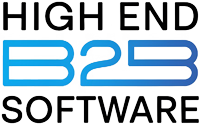Introduction: Building a SaaS Startup in 2025 Is No Joke
Remember when launching a SaaS product was just about writing code and getting a few customers?
Those days are long gone. Today, SaaS startups must juggle marketing automation, customer support, analytics, documentation, team collaboration, and scaling infrastructure—all while keeping burn low.
I’ve worked with more than 30 SaaS founders over the last 5 years, and I’ve noticed one truth:
Your tech stack will make or break your momentum. Choosing the right tools early on is the difference between scaling smoothly and drowning in operational chaos. Must-Have Tools for SaaS Startups. That’s why I’ve pulled together this guide to the 10 must-have tools every SaaS team should consider in 2025.
These are real solutions used by high-growth startups—not just popular names.
Disclosure:
This post contains affiliate links. If you grab something through them, I may earn a small commission—at no extra cost to you.
Let’s jump into the list.
Below, I’ll walk you through each tool with:
- Why I recommend it
- What makes it different
- Pros & Cons
- Who should actually use it
- My honest take
Pro Tip:
Before you commit, trial 2–3 options in each category.
See which fits your workflows best—not every popular tool is right for every SaaS model.
Tool #1: ClickUp — All-in-One Project Management
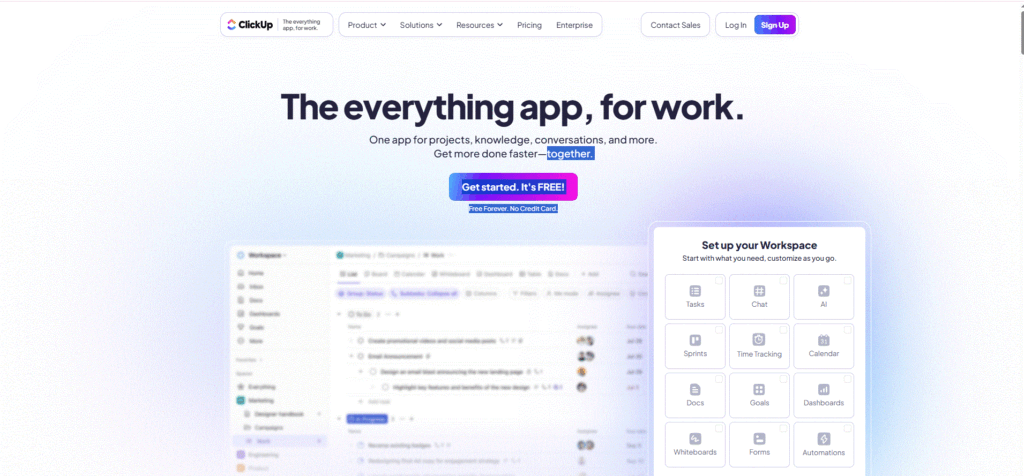
Why I Chose This Tool
If you’re growing a SaaS product, you need a system to keep engineering, marketing, and operations organized. ClickUp is the most flexible project management platform I’ve tested.
Official Website:
https://clickup.com
My Honest Take on the Features
- Multiple views: List, Board, Gantt, Calendar
- Time tracking built in
- Docs and wikis in the same workspace
- Real-time chat
- Automations and recurring tasks
What surprised me: Even the free plan is incredibly generous.
What Makes This Tool Different?
You can replace Trello, Asana, and Notion in one place.
Highly customizable workflows
Powerful reporting dashboards
Pros & Cons
Pros:
✅ Extremely flexible for teams of any size
✅ Generous free plan
✅ Time tracking and docs together
✅ Fast modern interface
Cons:
❌ Can feel overwhelming at first
❌ Takes time to set up properly
Unique Selling Points (USPs)
All-in-one platform—tasks, docs, chat
Advanced automations
Free forever plan
Who Should Actually Use This?
SaaS startups scaling past 5–10 people
Teams replacing multiple tools
Founders who want transparency across workflows
My Take:
After trying dozens of project management tools, ClickUp stood out for its flexibility. If you’re building a SaaS and don’t want to juggle 5 apps, start here.
Tool #2: Slack — Real-Time Team Communication
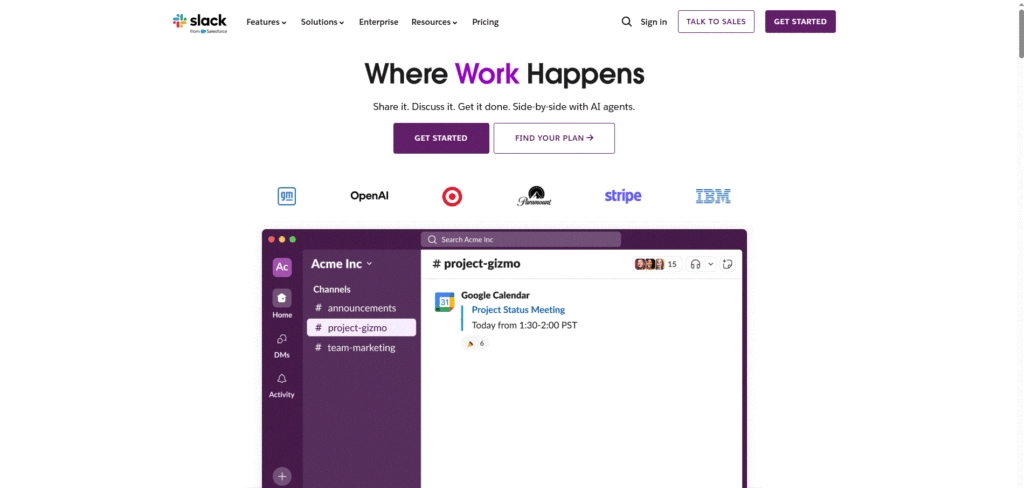
Why I Chose This Tool
When your SaaS team is distributed across time zones, email won’t cut it. Slack is the heartbeat of modern SaaS teams, making real-time communication effortless.
Official Website:
https://slack.com
My Honest Take on the Features
- Channels for every project
- Direct messaging and group chats
- Voice and video calls
- Integrations with GitHub, Jira, Google Drive
- Powerful search for all conversations
What surprised me: You can automate alerts from your app into Slack channels, which keeps everyone informed.
What Makes This Tool Different?
Intuitive UI that everyone already knows
Apps and integrations for almost anything
Notifications that actually work
Pros & Cons
Pros:
✅ Fast onboarding
✅ Rich integrations
✅ Searchable history
✅ Strong mobile apps
Cons:
❌ Can become noisy without discipline
❌ The free plan has message limits
Unique Selling Points
Central communication hub
Deep integrations
Excellent search functionality
Who Should Actually Use This?
SaaS teams >3 people
Remote-first companies
Startups scaling quickly
My Take:
To be honest, Slack can feel overwhelming without guidelines. But with good channel naming and notification rules, it’s the best team communication tool.
Tool #3: Intercom — Customer Support & Engagement
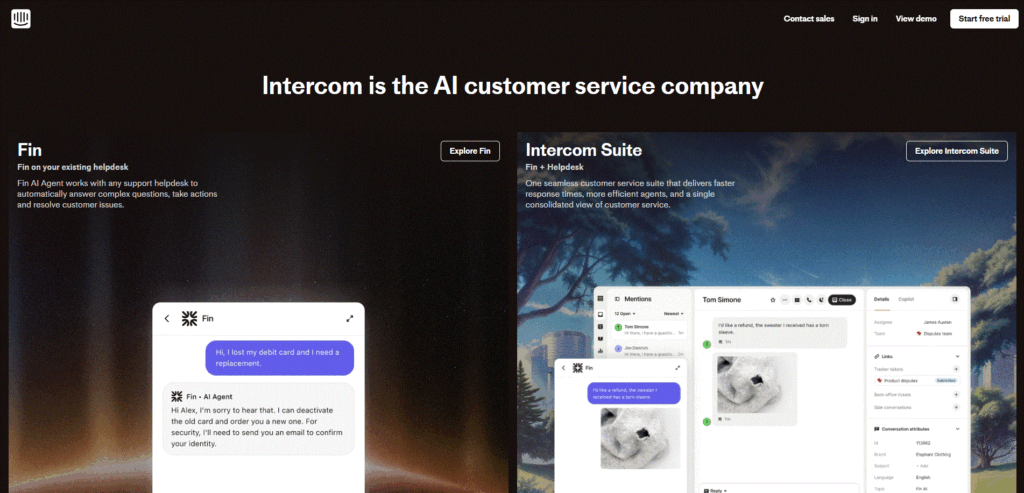
Why I Chose This Tool
SaaS companies live and die by how well they support and onboard customers. Intercom combines live chat, help desk, and onboarding flows into one platform.
Official Website:
https://www.intercom.com
My Honest Take on the Features
- Live chat widgets
- Automated onboarding messages
- Knowledge base and help center
- Customer segmentation
- Reporting dashboards
What surprised me: How easy it is to set up targeted campaigns inside the app.
What Makes This Tool Different?
Everything from onboarding to support in one place
Beautiful chat UI
Segmentation and automation that feel personal
Pros & Cons
Pros:
✅ All-in-one engagement platform
✅ Powerful automation
✅ Clear analytics
Cons:
❌ Expensive as you grow
❌ Setup can be time-consuming
Unique Selling Points
Conversational support + marketing
Smart triggers and workflows
Rich customer profiles
Who Should Actually Use This?
SaaS with high-touch onboarding
Apps needing in-app messaging
Growth-stage startups
My Take:
Intercom is premium software, but it pays off in customer satisfaction. Must-Have Tools for SaaS Startups. Worth every dollar if you can afford it.
Tool #4: Stripe — Payment Processing for SaaS
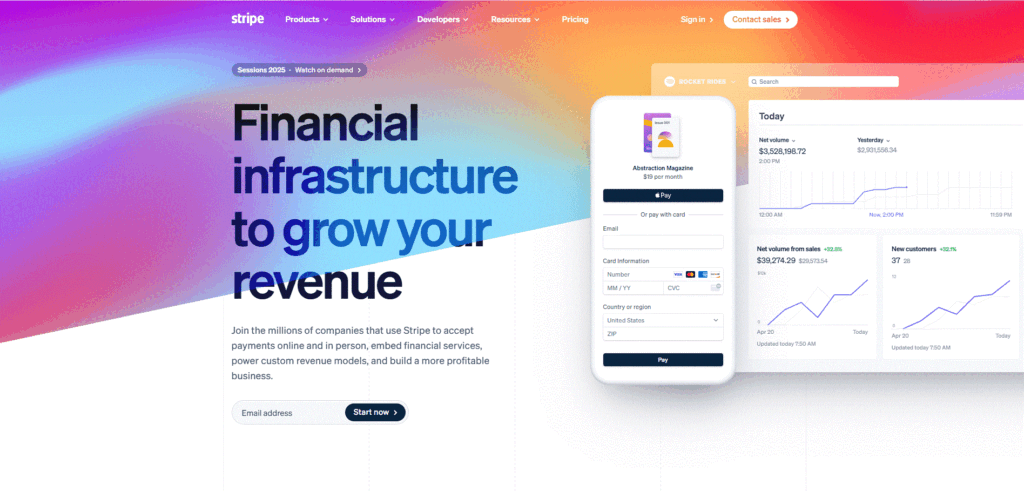
Why I Chose This Tool
Stripe is the de facto standard for handling subscriptions, billing, and payments globally.
Official Website:
https://stripe.com
My Honest Take on the Features
- Subscription billing
- One-time payments
- Custom checkout flows
- Reporting and payouts
- Tax and compliance support
What surprised me: Stripe has pre-built UI components that save huge development time.
What Makes This Tool Different?
Developer-first platform
Worldwide payments support
Rich APIs and documentation
Pros & Cons
Pros:
✅ Fast integration
✅ Global payments coverage
✅ Predictable pricing
Cons:
❌ Takes developer resources to set up
❌ Customer support can be slow
Unique Selling Points
Flexible subscription management
Modern APIs
Pre-built checkout and invoices
Who Should Actually Use This?
SaaS with recurring billing
Marketplaces
Startups selling globally
My Take:
Stripe is the gold standard for SaaS payments. You can’t go wrong if you have developers.
Tool #5: HubSpot CRM — Manage Your Customer Pipeline
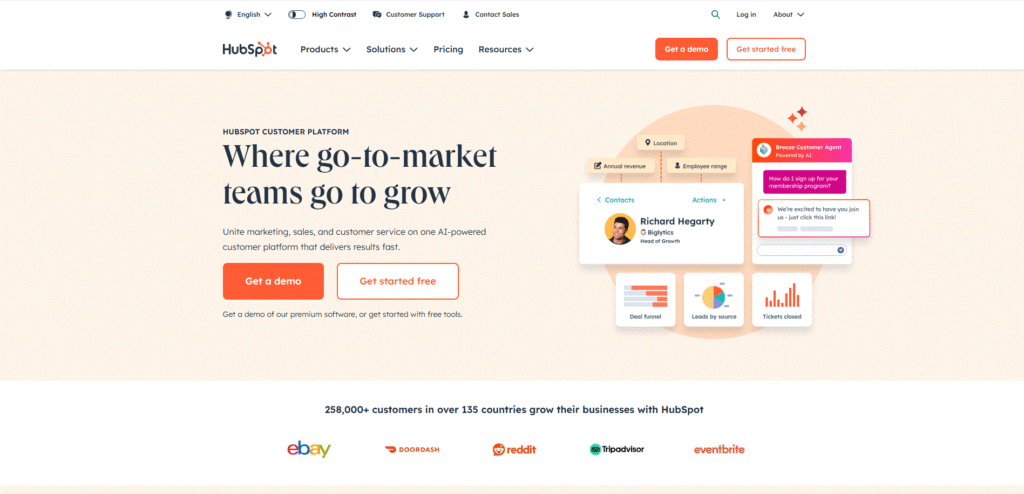
Why I Chose This Tool
HubSpot CRM is free to start and helps you track leads, conversations, and deals without spreadsheets.
Official Website:
https://www.hubspot.com
My Honest Take on the Features
- Contact and deal tracking
- Email templates and tracking
- Meeting scheduler
- Pipeline visualization
- Reporting dashboards
What surprised me: The free version is usable even for mid-sized teams.
What Makes This Tool Different?
Free forever CRM
Great email tools
Smooth UI
Pros & Cons
Pros:
✅ Free plan with solid features
✅ Integrates with Gmail and Outlook
✅ Clean interface
Cons:
❌ Some advanced features gated to paid tiers
❌ Can feel sales-focused
Unique Selling Points
Free CRM with no limits
Excellent contact management
Deep email integrations
Who Should Actually Use This?
Early-stage SaaS teams
Founders selling directly
Startups growing their pipeline
My Take:
HubSpot CRM is the perfect first CRM for SaaS founders who want a clean pipeline view.
Tool #6: Notion — Documentation & Knowledge Base
Why I Chose This Tool
Your team will need a single source of truth for docs, wikis, and notes. Notion is the most flexible option.
Official Website:
https://www.notion.so
My Honest Take on the Features
- Pages and sub-pages
- Databases and tables
- Embeds and integrations
- Templates for SOPs, roadmaps, etc.
What surprised me: How quickly teams adopt it without training.
What Makes This Tool Different?
Combines docs, wikis, and databases
Fast search
Beautiful design
Pros & Cons
Pros:
✅ Incredibly flexible
✅ Great templates
✅ Free plan for small teams
Cons:
❌ No offline mode for all features
❌ Can feel overwhelming
Unique Selling Points
All-in-one knowledge base
Clean design
Templates for everything
Who Should Actually Use This?
Startups building SOPs
Remote SaaS teams
Founders managing knowledge
My Take:
Notion is essential for documenting processes as you scale.
Tool #7: Segment — Customer Data Platform
Why I Chose This Tool
If you want to understand your users and connect all analytics tools, Segment is the easiest way to unify your data.
Official Website:
https://segment.com
My Honest Take on the Features
- Tracks user events across web, app, and servers
- Sends data to 200+ destinations (Mixpanel, Google Analytics, Amplitude)
- Provides clean, consistent data schema
- Supports GDPR compliance
What surprised me: How much engineering time it saves long term.
What Makes This Tool Different?
One API to rule them all
Excellent developer docs
Real-time data pipelines
Pros & Cons
Pros:
✅ Simplifies analytics integrations
✅ Clean, consistent data
✅ Scales with your business
Cons:
❌ Paid plans are expensive
❌ Initial setup can be complex
Unique Selling Points
One place to manage user events
GDPR-friendly data flows
Rich integrations
Who Should Actually Use This?
SaaS products tracking user behavior
Growth teams needing unified metrics
Startups planning to scale fast
My Take:
If you care about product analytics and marketing attribution, Segment is irreplaceable.
Tool #8: Zapier — No-Code Workflow Automation
Why I Chose This Tool
Zapier lets you automate repetitive tasks without hiring engineers—perfect for lean SaaS teams.
Official Website:
https://zapier.com
My Honest Take on the Features
- Connects 5,000+ apps (Slack, HubSpot, Stripe)
- Multi-step workflows
- Conditional logic
- Auto-retries and error handling
What surprised me: You can build entire onboarding workflows in a day.
What Makes This Tool Different?
No-code setup
Huge library of integrations
Powerful automation without developers
Pros & Cons
Pros:
✅ Saves time on manual tasks
✅ Easy to learn
✅ Affordable for startups
Cons:
❌ Can get messy without naming conventions
❌ Limited scalability vs. custom code
Unique Selling Points
No-code automations
Massive app directory
Fast implementation
Who Should Actually Use This?
SaaS teams automating lead flows
Small teams saving time
Non-technical founders
My Take:
Zapier is the first automation tool I recommend to SaaS teams—so much ROI for little effort.
Tool #9: Mixpanel — Product Analytics
Why I Chose This Tool
Mixpanel helps you understand how users engage with your product so you can improve activation and retention.
Official Website:
https://mixpanel.com
My Honest Take on the Features
- Event tracking
- Funnels and cohorts
- Retention reports
- Custom dashboards
What surprised me: How powerful the free plan has become.
What Makes This Tool Different?
Laser-focused on product analytics
Intuitive UI
Powerful segmentation
Pros & Cons
Pros:
✅ Detailed user behavior insights
✅ Easy funnel visualization
✅ Free plan with core features
Cons:
❌ Learning curve for advanced reports
❌ Setup requires developer help
Unique Selling Points
Funnel and cohort analysis
Beautiful dashboards
Great for SaaS growth
Who Should Actually Use This?
Product-led SaaS
Teams improving onboarding and retention
Founders tracking feature adoption
My Take:
Mixpanel is the gold standard for SaaS product analytics.
Tool #10: Loom — Video Messaging for Sales and Support
Why I Chose This Tool
Instead of long emails, Loom lets you send quick screen and video recordings to customers or teammates.
Official Website:
https://www.loom.com
My Honest Take on the Features
- Screen and camera recording
- Instant shareable links
- Viewer insights
- Call-to-action buttons
What surprised me: How much faster it is than writing explanations.
What Makes This Tool Different?
Videos record and upload in real time
Simple UI
Time-stamped comments
Pros & Cons
Pros:
✅ Saves time
✅ Makes communication human
✅ Free plan available
Cons:
❌ Limited video editing
❌ Branding on free tier
Unique Selling Points
Fast screen recording
Viewer engagement tracking
Easy sharing
Who Should Actually Use This?
SaaS teams supporting customers
Founders doing sales outreach
Remote teams explaining processes
My Take:
Loom is indispensable for clear, personal communication—especially in remote teams.
Ultimate Comparison Table: 10 Must-Have Tools for SaaS Startups in 2025
| Feature | ClickUp | Slack | Intercom | Stripe | HubSpot CRM | Notion | Segment | Zapier | Mixpanel | Loom |
|---|---|---|---|---|---|---|---|---|---|---|
| Best For | All-in-one project management | Team communication | Customer support & engagement | Payments & subscriptions | Sales pipeline | Documentation & wikis | Customer data integration | No-code automations | Product analytics | Video messaging |
| Ease of Use | Moderate learning curve | Very easy | Moderate setup | Developer setup required | Easy for small teams | Very easy | Technical setup required | Very easy | Moderate learning curve | Very easy |
| Free Plan | ✅ Yes | ✅ Yes | ✅ Limited trial | ✅ Pay-as-you-go | ✅ Yes | ✅ Yes | ✅ Developer plan | ✅ Yes | ✅ Yes | ✅ Yes |
| Unique Strength | Tasks + Docs + Chat | Centralized messaging | In-app chat + onboarding | Global payments + billing | Free CRM | Flexible docs | Unified analytics pipeline | Automate any workflow | Funnel & cohort analysis | Fast video explanations |
| Integrations | 1,000+ | 2,500+ | Many CRMs and marketing tools | 135+ payment methods | Gmail, Outlook, Zapier | Slack, GitHub | 200+ destinations | 5,000+ | Many data warehouses | Slack, Gmail |
| Pricing Starts | Free | Free | Paid plans only | Pay per transaction | Free | Free | Free developer tier | Free | Free | Free |
| Our Verdict | Best for managing everything | Best for communication | Best for support | Best for billing | Best free CRM | Best for documentation | Best for analytics integration | Best for automation | Best for product analytics | Best for human connection |
Pro Tip:
Pick 1–2 core tools per category, not everything at once.
(FAQ) For Must-Have Tools for SaaS Startups
What’s the best tool to start with if I have a very small team?
Slack + Notion—you’ll get communication and documentation without cost.
Which tool will help me accept global payments fastest?
Stripe—you can set it up in days if you have developer help.
Which project management platform is most flexible?
ClickUp—you can replace Trello, Asana, and Docs in one tool.
I want no-code automation—what should I use?
Zapier—connect thousands of apps with no engineering.
How can I see how users engage in my SaaS product?
Mixpanel—best for funnel and retention analysis.
What about recording quick video guides for my team?
Loom—perfect for asynchronous explanations.
Which CRM should I start with on a budget?
HubSpot CRM—free forever for core features.
Which tool helps unify my data stack?
Segment—tracks user events and syncs data to other platforms.
Is Intercom worth the money for small teams?
Only if you have high-touch onboarding—otherwise, consider cheaper options.
Which tool is essential for documenting SOPs?
Notion—fast, beautiful, and flexible.
Final Thoughts: How to Build Your SaaS Tech Stack with Confidence
Building a SaaS company in 2025 is both simpler and harder.
You have incredible tools at your fingertips—but too many choices can paralyze you.
Here’s what I recommend:
Start lean:
- Slack + Notion + Stripe
Layer in growth:
- ClickUp for operations
- HubSpot CRM for sales
Add data and automation:
- Segment + Mixpanel + Zapier
Keep communication personal:
- Intercom + Loom
Pro Tip:
Sign up for free trials before you commit.
Test them on a real project.
See what your team actually enjoys using.
Disclosure:
This post contains affiliate links. If you grab something through them, I may earn a small commission—at no extra cost to you.
Top 7 B2B Marketing Automation Tools for Agencies – Discover the best automation platforms to drive
